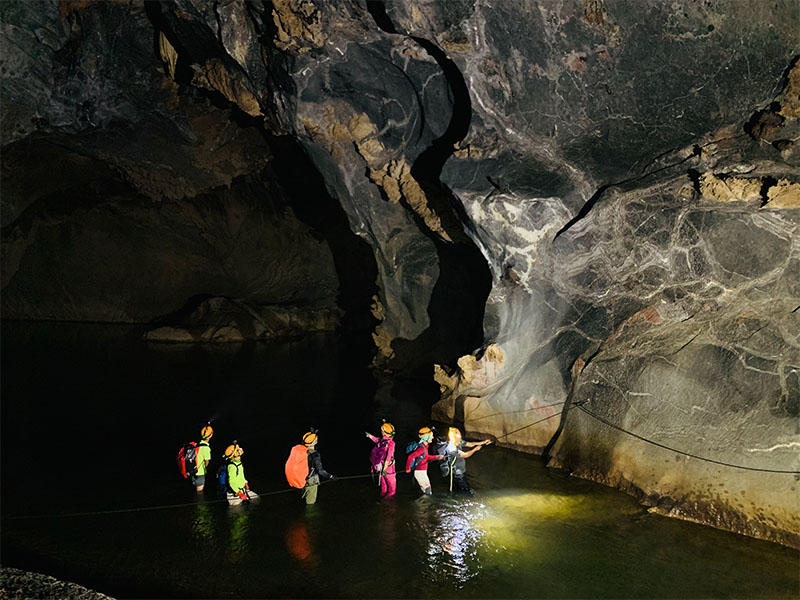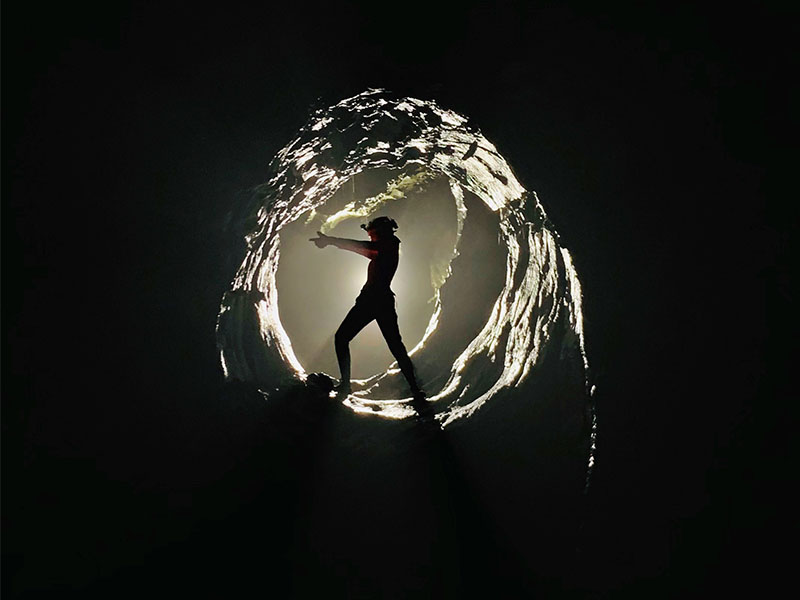The siren call was impossible to resist. The moment she heard about Vietnam’s gigantic Son Doong Cave, CHRISTINE AMOUR-LEVAR knew she had to see it with her own eyes.
Son Doong Cave (or Hang Son Doong as it’s also known) is the largest cave in the world. It is an otherworldly place full of wilderness and grandeur; a true masterpiece of nature with awe-inspiring landscapes, enormous stalagmites and statuesque stalactites hanging from the ceiling and rising from the ground like alien species. They say life is about great friendships and spectacular adventures. Our week-long jungle expedition to the heart of Son Doong Cave in Central Vietnam turned out to be exactly that, an unforgettable journey to a magical place as ancient as time, where we found ourselves constantly at a loss for words in front of so much stunning beauty and splendour.
Located in the heart of the UNESCO-listed Phong Nha Ke Bang National Park in the Quang Binh province of Vietnam, Son Doong was originally discovered by a local farmer in 1991. He didn’t dare venture in because he thought the powerful and mysterious wind blowing from inside the cave came from monsters of local mythology. The cave was then explored in 2009 and 2010 by the British Cave Research Association. It’s now open to the public, but only officially since 2013.

Getting there is the first challenge
In Vietnamese, Hang Son Doong means “Mountain River Cave”, and the grotto wears its name well, since it has its own underground jungle and ecosystem, with trees rising 30 metres above ground and a sinuous river that rushes through its gigantic chambers – distinct features that set this cave apart from so many others around the world.
The journey to the cave entrance involved two days of intense trekking through thick jungle, multiple river crossings and one night of camping in Hang En Cave (itself the third largest in the world!).
Once at the entrance of Song Doong, we harnessed up and abseiled down about 80 metres through tight and slippery passages, scrambling over huge boulders and into the cavernous belly of the mother of all grottos.
Travelling through the cave’s depths required intense concentration. We had to stay alert at all times, lest we trip on the slippery rocks and tumble into a ravine lined with razor-sharp stones. Up and down we went using the wooden ladders wedged between the rocks, sometimes removing our backpacks so we could squeeze through tiny crevices, splashing across icy rivers, wading through muddy streams, pulling ourselves up with ropes or sliding down on our muddy bums over sloping stone walls and balancing precariously on narrow, rickety bridges to cross wide-open, echoing spaces.
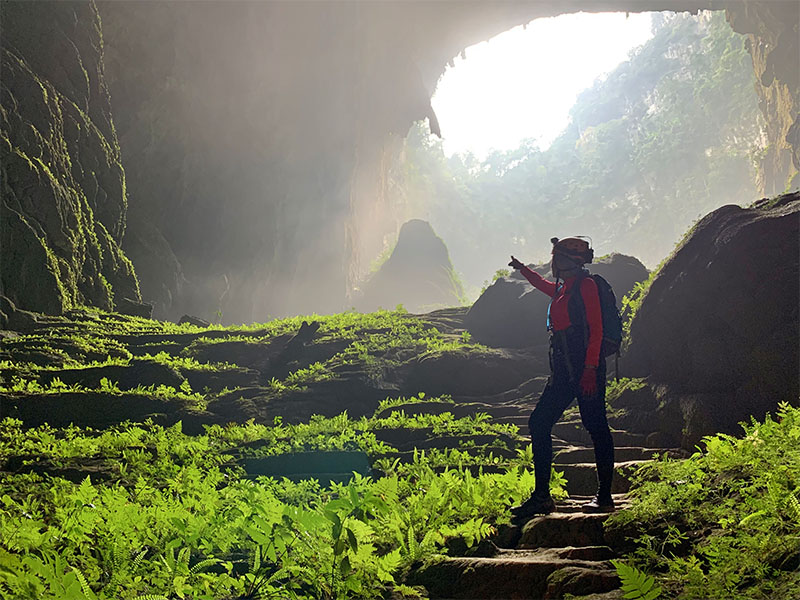
A place like no other
The cave’s proportions are extraordinary. Its main chamber is the largest in the world by volume, measuring approximately nine kilometres long, 200 metres high and 150 metres wide. The only way to get a true sense of perspective on the sheer size of Son Doong is to have fellow trekkers scatter throughout the limestone galleries. Even then, it’s hard to properly comprehend the enormity of a place that could house an entire New York City block or even allow a 747 to fly through its main passage.
The difference in temperature between the air inside and outside of the cave creates hovering clouds of mist that give rise to a miraculous and surreal atmosphere, enveloping areas of the cave in a dense fog and contributing to the eerie sensation. The vegetation is diverse, with lush, green foliage in parts where the sun’s rays break through the openings, and practically non-existent in the hallowed dark chambers of the cave.
Because of the colossal size and the high levels of rainfall in the region, erosion happens at an accelerated rate. Occasionally, the weight of the limestone gives way and collapses, creating what is known as a “doline” (from the Slovenian word dolina, meaning “valley”). These sinkholes create huge gateways to the outside world and at certain times of the year when the conditions are right, incredible sunbeams penetrate these exposed sections, creating a mesmerising light show.
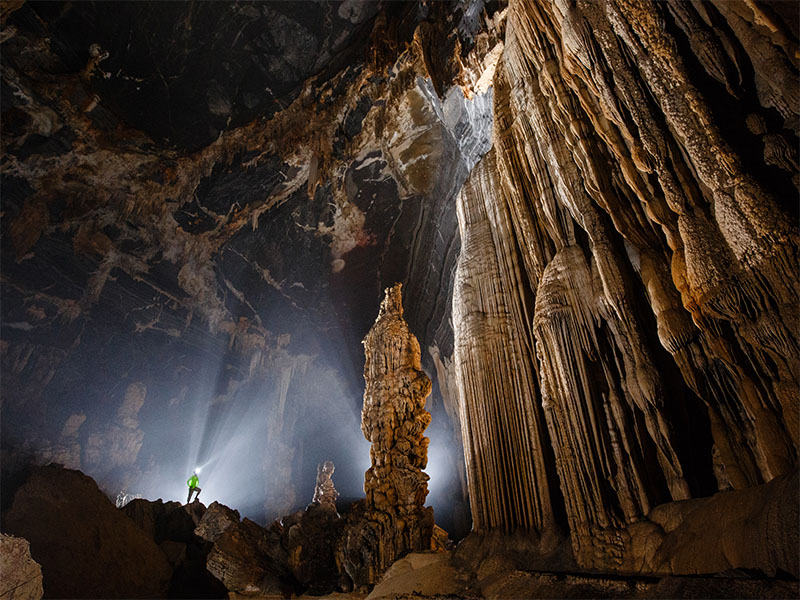
Signs of life
During pauses in our itinerary, we would shine our helmet torchlights on the colossal limestone ceiling above our heads and marvel at the awe-inspiring majesty of this underground cavern. In those moments, we’d be reminded of how rare this whole experience truly was. Indeed, fewer people have seen inside Son Doong Cave than have stood on the summit of Mount Everest.
Our Vietnamese guide, Vu, shared that the cave was estimated to be about two to five million years old, and originally formed by river water eroding weak limestone underneath the mountain, creating huge skylights. We saw fossils believed to be millions of years old and thousands of cave “pearls” neatly packed into terraced compartments on the grotto floor. The pearls are a natural phenomenon formed over hundreds of years when dripping water creates layers of calcite that build up around grains of sand.
At other times, we encountered crawling white insects, almost transparent in hue, that had probably never seen the light of day; or we would step over the remains of small animals such as deer and rats, their bones mixed with mud and dust. One morning on the first day of the expedition, we were awakened by the chirping of hundreds of swifts sweeping across the cavernous hall above our heads. The whole experience was surreal.
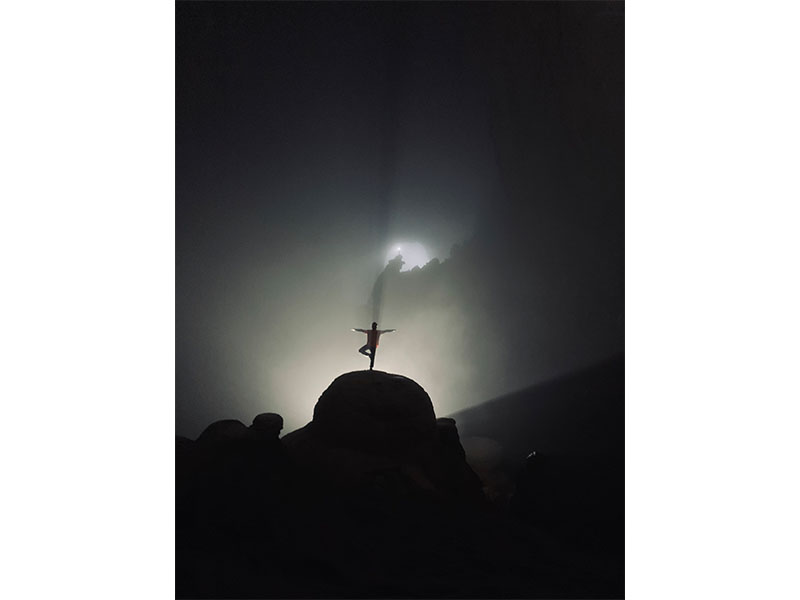
Involving and helping local communities
This was a spectacular expedition from start to finish, and one that required a team of 28 to assist us: one national park ranger, five safety guide assistants, one lead guide, one British caving expert, two chefs, seventeen porters and one porter team leader. They really were the heart and soul of our journey. In the same way that the Sherpas of Nepal are instrumental to a climber’s success in summiting some of the highest peaks, the local porters of Son Doong are the true heroes of this multi-day caving expedition. These men all hail from Quang Binh, one of Vietnam’s poorest provinces, and they come from a variety of working backgrounds – farming, hunting, logging and more.
The voyage was made even more poignant because our HER Planet Earth team was supporting a very meaningful cause. This expedition’s aim was to raise awareness and funds for programmes that help the economic empowerment of women in rural Vietnam, strengthening their climate change resiliency. Thus, from the onset, thanks to this shared vision, our team was united in its purpose and humanity.

Heading home
As we left the cave – using ropes to ascend the “Great Wall of Vietnam”, a calcite wall some 90 metres high – my heart sank a little. A part of me wanted to run back to this precious Garden of Eden. Had we stepped back in time through a magical passage, deep inside the earth’s inner core? Or perhaps taken a voyage to a lost world millions of years old? It felt that way to me. So much so that returning to my daily life took some time and readjustment.
As I look back, I feel privileged to have witnessed a glimpse of what the world must have looked like when dinosaurs roamed the earth and humanity was not even in its nascent stages. Somehow, down there, far from civilisation’s hustle and bustle, everything seemed so much purer and simpler.
HER Planet Earth is a global women’s advocacy movement headquartered in Singapore. The not-for-profit organisation undertakes self-funded expeditions to increase awareness of environmental degradation and raise funds for programmes that empower and educate underprivileged women affected by climate change.
Like this? Read more in our Travel section!
This article first appeared in the June 2019 edition of Expat Living. You can purchase a copy or subscribe so you never miss an issue!


